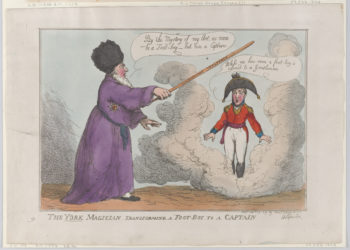This week it was announced that IOP Publishing (IOPP) had signed a three-year “read and publish” transformative agreement with the Canadian Research Knowledge Network (CRKN) – the first such agreement for IOPP in North America. I posed a few questions about the agreement* to Julian Wilson, IOPP’s sales and marketing director.

Can you tell us about the Canadian Research Knowledge Network? What kinds of institutions does it include, and in roughly what proportions?
The Canadian Research Knowledge Network represents 81 member institutions across Canada for content acquisition and licensing. Its key aims include advocating for fair and sustainable access to public research and content; and transforming scholarly communications in Canada. Its members include world-class academic libraries and research institutions, two national libraries, and Canada’s largest public library system. IOP’s agreement with CRKN extends to 45 participating members, which represent the majority of Canadian research with IOP Publishing.
How are those 45 participant institutions distributed in terms of institution type? Beyond the very obvious (I would imagine that the public library system is not participating, for example) do you finding that certain institution types are more/less interested than others?
By far most CRKN members taking part represent university academic libraries and research institutions – but, that is also the majority of the general membership. Some smaller sites and universities without relevant research interests are also not taking part. A full list of institutions taking part as well as the workflow for authors is available from IOPP’s publishing support website.
Roughly how many articles do CRKN member organizations publish in IOPP journals in a typical year?
Corresponding authors affiliated to CRKN members currently publish around 290 articles a year within IOP Publishing and its partner society hybrid journals. Over the course of the three-year agreement up to 100% of published articles from participating CRKN members in these journals could become open access without any additional OA costs over the term of the license. The agreement also includes all IOP Publishing’s own fully open access journals, ensuring authors can publish in these journals without any direct cost to themselves or the library – currently around 50 articles a year.
If participating members publish more OA articles than provided for under this agreement, is that overage charged at the standard APC rate for the journals in question? If not, is some kind of discount applied?
Our agreement is ‘unlimited’ – for all eligible fully open access and hybrid journals – there are no fees for additional publishing throughout the term of the license. In fact, the model is transformative in a way that should publishing output grow over the license term, the publishing element of the fee will increase, and the read fee will reduce. At no point will additional APCs be levied on authors or libraries for eligible articles. We believe this is a key component of transformational agreements in order to provide certainty for researchers, constrain costs, and allow existing funding to support the move to open access.
Does this deal replace a previous consortium-wide read-only deal with IOPP? If so, can you give us an idea of whether it represents an increased, decreased, or steady-state level of spend for the consortium?
IOPP have a long-standing partnership with CRKN but based on the provision of reading services only until now. A sustainable transformative agreement has been reached that retains all previously provided reading services whilst enabling unlimited publishing for a small increase in the total costs for consortium members. We aim to provide a sustainable move towards open access that recognizes the value of open access publishing by shifting fees away from the reading component of our agreements towards publishing services for the consortium and its members.
Are the specific financial terms of the deal publicly available? I imagine they could be of great interest to Scholarly Kitchen readers who may be at institutions or organizations pondering the possibility of joining their own transformative deal.
The general agreement information can be made available by CRKN on ESAC; however, it is not yet uploaded. The specific financial terms are not made available.
At the end of this initial three-year period, what criteria will CRKN and IOPP use to determine the success of this program and decide whether to continue it?
We seek to transform as much research as possible from paywalled access to fully open, CC BY articles. Under our transformative agreement, we aim to see uptake of OA publishing well exceed 90% for eligible journals. With the agreement being unlimited in nature across both hybrid and fully-OA journals, there is the ability for funding to shift even further towards ‘publishing’ with growth in open articles without any additional expenditure by any member institutions or authors.
Is that 90% a goal threshold for the end of deal’s three-year term, or are you anticipating reaching it earlier than that?
The 90% isn’t a specific threshold: it’s an expectation we have. IOPP’s transformative agreements routinely lead to over 90% of eligible research being open access. For example, we now see close to 100% open access publishing (of eligible articles) with our agreement with the Swedish Consortium (Bibsam), and we expect the same uptake levels from all of our new transformative agreements.
Do you know what percentage of CRKN-authored publications are currently published on an OA basis in IOPP and society partner journals? (How much of an increase would that 90% threshold represent?)
Without this agreement, we expect less than a third of the articles would be open access – and the majority of those are in fully open access titles. For IOPP’s hybrid journals, the agreement will mean a shift from under 5% of articles being published open access (2020), to close to 100% (authors do sometimes opt out of course). That transformation will take place almost immediately – there is no staggered start – we have already started identifying and making articles open under the agreement.
Granted that CC BY is the default license for articles published under this arrangement, do authors have the option of selecting a different license if they wish?
CC BY is set as standard across the board. The only exception is for articles published in the journals of the Electrochemical Society which offer authors the option of a CC-BY-NC-ND.
* After this interview was posted, I was contacted by Rebecca Ross, CRKN’s Director of Strategy and Engagement. She provided a link to the full agreement (including financial details; there is no confidentiality clause in the agreement), and offered the following clarifications and corrections to some of the information about CRKN given by Julian Wilson:
-
- 76 of CRKN’s 81 member institutions participate in the consortium’s large-scale licensing and content acquisition programs. Of those 76, 45 are signatories to the deal with IOPP. All of these are university libraries.
- It is true that CRKN’s fee increases are fixed by contract, and will not be impacted by an increase in publishing output. However, how IOPP internally assigns portions of those fees between read and publishing charges may change at any time, at IOPP’s discretion.
- Julian’s response to the question “What criteria will CRKN and IOPP use to determine the success of this program?” represent’s IOPP’s position only, not that of CRKN.



